
MC-50BT • MC-60BT Wireless Headphones with Wide-Band Active Noise Cancelling
2
MC-50BT • MC-60BT Wireless Headphones with Wide-Band Active Noise Cancelling
Important Safety Instructions
1. Read, follow, and keep these instructions. Heed all warnings.
2. Do not use in or near dangerous environments. This includes driving,
cycling, walking, jogging and other areas where trac is present
and accidents could occur.
3. Keep this product and its accessories out of reach of children. Handling
or use by children may pose a risk of death or serious injury. Contains
small parts and cords that may pose a risk of choking or strangulation.
4. Set the volume level of the audio device to a minimum, and then,
afer connecting the earphones, adjust the volume gradually.
Sudden exposure to loud noises could cause hearing damage.
5. Keep headphones clean. To clean the headphones, wash outside
with a mild detergent solution.
6. Do not attempt to modify this product. Doing so could result in personal
injury and/or product failure.
7. Do not immerse in water, such as while taking a shower, bath, or washing
your face. Otherwise, sound deterioration or failures may result.
8. Do not use while sleeping as accidents may result.
9. Use a slow twisting motion to remove the earphones.
Never pull on the earphone cord.
10. Stop using the earphones immediately if they are causing great discomfort,
irritation, rash, discharge, or any other uncomfortable reaction.
11. If you are currently receiving ear treatment, consult your physician
before using this device.
12. Operating Temperature: –0˚–+50˚ C // 4–22˚ F
Charging Temperature: 0˚–+45˚ C // 32–3˚ F
Storage Temperature: –20˚–+60˚ C // –4–40˚ F
13. This equipment complies with FCC radiation exposure limits set forth
for an uncontrolled environment. This device should be installed and operated
with minimum distance 20cm between the radiator & your body. This transmitter
must not be co-located or operating in conjunction with any other antenna
or transmitter.
14. CAN RSS-26 / CNR-26
This equipment complies with IC RSS-02 radiation exposure limits set forth
for an uncontrolled environment. This transmitter must not be co-located
or operating in conjunction with any other antenna or transmitter.
This equipment should be installed and operated with minimum
distance 20cm between the radiator and your body.
CAN RSS-26 / CNR-26
Cet équipement est conforme aux limites d’exposition aux radiations IC CNR-02
établies pour un environnement non contrôlé. Cet émetteur ne doit pas être situé
ou fonctionner conjointement avec une autre antenne ou un autre émetteur.
Cet équipement doit être installé et utilisé avec une distance minimale de 20 cm
entre le radiateur et votre corps. Este dispositivo debe ser instalado y usado
con una separación mínima de 20 cm entre el radiador y el cuerpo.
15. This device complies with Part 5 of the FCC Rules [and contains
license-exempt transmitter(s)/receiver(s) that comply with Innovation,
Science and Economic Development Canada’s license-exempt RSS(s)].
Operation is subject to the following two conditions:
() this device may not cause harmful interference, and
(2) this device must accept any interference received,
including interference that may cause undesired operation of the device.
L’émetteur/récepteur exempt de licence contenu dans le présent appareil
est conforme aux CNR d’Innovation, Sciences et Développement économique
Canada applicables aux appareils radio exempts de licence. L’exploitation
est autorisée aux deux conditions suivantes:
() l’appareil ne doit pas produire de brouillage, et
(2) l’appareil doit accepter tout brouillage radioélectrique subi, même
si le brouillage est susceptible d’en compromettre le fonctionnement.
High sound pressure. Hearing damage risk.
Do not listen at high volume levels for long periods.
WARNING — The battery (battery or batteries or battery pack) shall
not be exposed to excessive heat such as sunshine, fire or the like.
16. This equipment complies with FCC and ISED radiation exposure limits set forth
for an uncontrolled environment. In case this equipment has to subject to FCC/
IC SAR (Specific Absorption Rate) exposure test, this equipment is designed to
meet the requirements for exposure to radio waves established by the FCC and
ISED. These requirements set a SAR limit of .6 W/kg averaged over one gram
of tissue. The highest SAR value reported under this standard during product
certification for use when properly worn on the body or on the head, with no
separation. To meet RF exposure guidelines and reduce exposure to RF energy
during the operation, this equipment should be positioned at least this distance
away from the head.
17. NOTE: This equipment has been tested and found to comply with the
limits for a Class B digital device, pursuant to part 5 of the FCC Rules.
These limits are designed to provide reasonable protection against harmful
interference in a residential installation. This equipment generates, uses,
and can radiate radio frequency energy and, if not installed and used in
accordance with the instructions, may cause harmful interference to radio
communications. However, there is no guarantee that interference will
not occur in a particular installation. If this equipment does cause harmful
interference to radio or television reception, which can be determined
by turning the equipment o and on, the user is encouraged to try
to correct the interference by one or more of the following measures:
• Reorient or relocate the receiving antenna.
• Increase the separation between the equipment and the receiver.
• Connect the equipment into an outlet on a circuit dierent from that
to which the receiver is connected.
• Consult the dealer or an experienced radio/TV technician for help.
CAUTION: Changes or modifications to this device not expressly
approved by LOUD Audio, LLC. could void the user’s authority
to operate the equipment under FCC rules.
Canada ICES-003(B)/NMB-003(B)
18. RF Power: ≤20dBm
Bluetooth frequency range: 2400~2483.5 MHz
19. Exposure to extremely high noise levels may cause permanent hearing loss.
Individuals vary considerably in susceptibility to noise-induced hearing loss,
but nearly everyone will lose some hearing if exposed to suciently intense
noise for a period of time. The U.S. Government’s Occupational Safety
and Health Administration (OSHA) has specified the permissible noise
level exposures shown in the following chart.
According to OSHA, any exposure in excess of these permissible limits
could result in some hearing loss. To ensure against potentially dangerous
exposure to high sound pressure levels, it is recommended that all persons
exposed to equipment capable of producing high sound pressure levels
use hearing protectors while the equipment is in operation. Ear plugs
or protectors in the ear canals or over the ears must be worn when
operating the equipment in order to prevent permanent hearing
loss if exposure is in excess of the limits set forth here:
Duration, per
day in hours
Sound Level dBA,
Slow Response
Typical Example
8 90 Duo in small club
6 92
4 95 Subway Train
3 97
2 00 Very loud classical music
.5 02
05 The dogs barking at the mailman
0.5 0
0.25 or less 5 Loudest parts at a rock concert
CAUTION — A battery subjected to extremely low air pressure may result
in an explosion or the leakage of flammable liquid or gas.
CAUTION — Danger of explosion if battery is incorrectly replaced.
Replace only with the same or equivalent type.
NOTE ON STATIC ELECTRICITY
Static electricity accumulated in the body may cause mild tingling in your ears.
To minimize the eect, wear clothes made from natural materials.
Correct disposal of this product: This symbol indicates that this product should not be disposed of with your household waste, according to the WEEE directive (202/9/EU) and your national law.
This product should be handed over to an authorized collection site for recycling waste electrical and electronic equipment (EEE). Improper handling of this type of waste could have a possible
negative impact on the environment and human health due to potentially hazardous substances that are generally associated with EEE. At the same time, your cooperation in the correct disposal
of this product will contribute to the eective usage of natural resources. For more information about where you can drop o your waste equipment for recycling, please contact your local city
oce, waste authority, or your household waste disposal service.

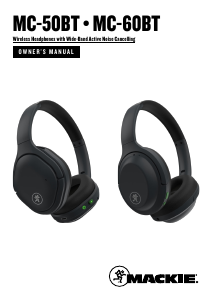


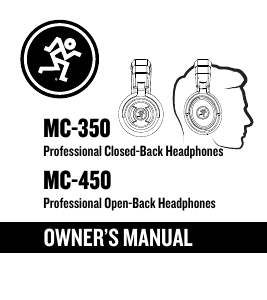

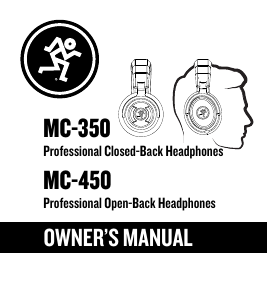
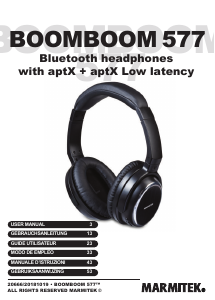
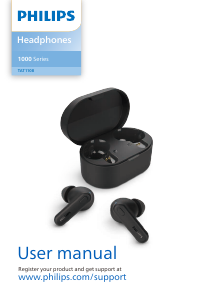
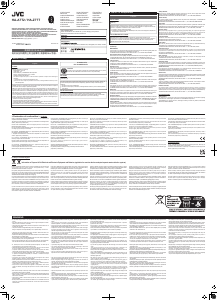

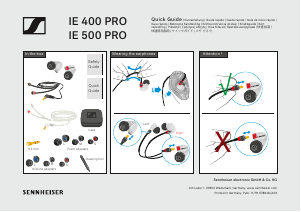
Join the conversation about this product
Here you can share what you think about the Mackie MC-50BT Headphone. If you have a question, first carefully read the manual. Requesting a manual can be done by using our contact form.